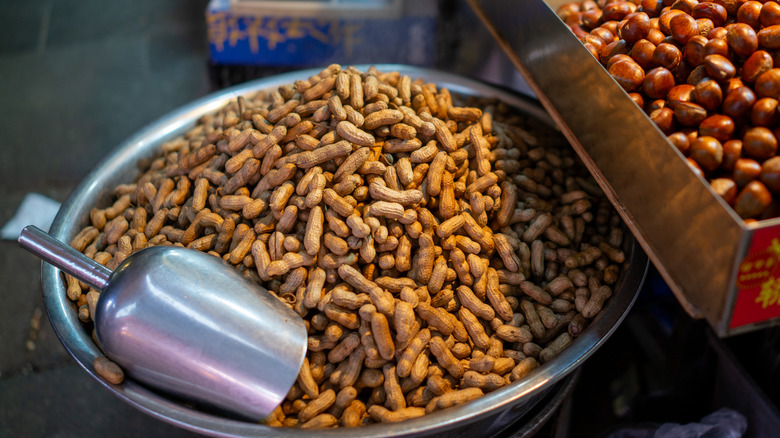This Salty Canned Snack Has Deep Southern Roots
We may receive a commission on purchases made from links.
Pull off any highway in Georgia or the Carolinas during late summer, and you'll encounter roadside stands advertising boiled peanuts. Steam rises from enormous kettles while vendors ladle the sodden legumes into paper bags. The snack is also sold in cans by brands like Peanut Patch and Plantation. You can even find generic versions, like this 6-pound can of Cajun boiled peanuts that sells on Amazon for about $20. This humble Southern comfort food carries centuries of history and cultural exchange.
Evidence suggests that the practice of boiling peanuts originated in West Africa, where enslaved people brought knowledge of preparing similar legumes to the American South. Initially called "goober peas" in the United States, they gained greater significance in the 19th century. During the Civil War, when Confederate soldiers found themselves cut off from supply lines, boiled peanuts served as emergency rations. After the conflict, as farmers in the South sought alternatives to cotton, peanuts experienced a boom throughout the region.
The year 1899 might have marked the first published recipe for boiled peanuts, which appeared in Almeda Lambert's vegetarian cookbook "Guide for Nut Cookery." During the early and mid-1900s, the food's prevalence in parts of South Carolina made headlines. By 1925, boys in the city of Orangeburg were selling bagged boiled peanuts for a nickel apiece.
Boiled peanuts are a Southern gem
If you don't live near a store that sells boiled peanuts and don't want to pay to have them shipped, preparing the snack is simple. Raw, green peanuts simmer for several hours in heavily salted water until they achieve their characteristic soft interior. Some cooks like to add Cajun spices, beer, or ham hock, but purists insist on salt alone. South Carolina elevated boiled peanuts to official state snack status. They appear at gas stations, ballparks, and festivals across the state. Dubbed the "caviar of the South," they represent something far more precious than their modest price suggests.
Unlike their roasted cousins, boiled peanuts have a bean-like consistency, infused with the seasonings that accompany their long simmer. They're messy to eat, resulting in fingers sticky with brine. However, boiled peanuts are more than just a snack. They bridge the past and present, reminding us that the most meaningful foods often emerge from necessity. While these legumes are a regional food outsiders may never understand, they have a backstory worth knowing.

